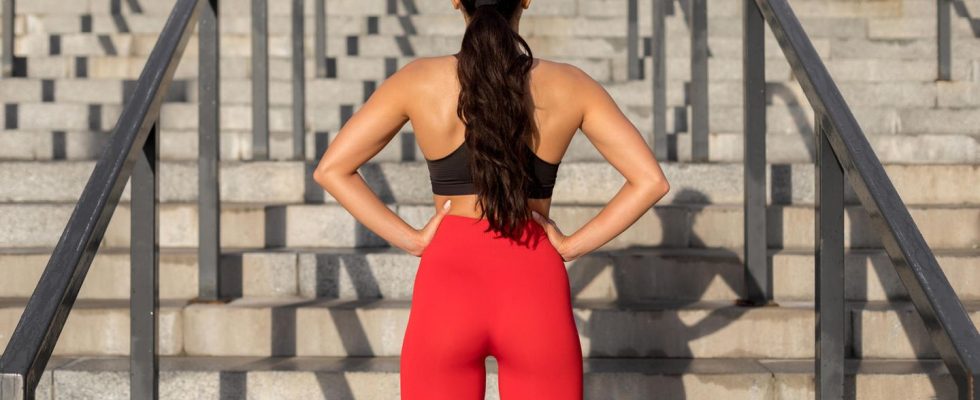Opinion
After thigh gap
“Leggings Legs” on TikTok: We don’t need a rebirth of toxic beauty ideals
The Tiktok trend “Leggings Legs” unfortunately rehashes an old ideal of beauty
© Getty Images
Our author believes that no one needs some beauty trends, especially if they were rubbish around ten years ago. Why the revival of “Leggings Legs” on Tiktok is so dangerous for young women and girls.
Some revivals on social media make hearts beat faster – like Sophie Ellis Bextor’s “Murder on the Dancefloor”. Other Reincarnations are better left to rot in a mothballs. Like the “thigh gap”. This beauty cult from hell was already trending on the social network Tumblr in the early 2010s. Unfortunately, such beauty trends never went away. But now, of all things, the thigh gaps are back. Only today they are called “Leggings Legs”.
While it used to be photos, today it’s videos on Tiktok. With the same message: Anyone who has a clear gap between their thighs when standing with their legs together is beautiful. And only a select group of women are allowed to wear leggings according to this trend. The remaining women, well, they are demoted as fat and ugly. Or more commonly used today: bodyshamed.
“Leggings Legs” on Tiktok: Dangerous skinny cult
With the “Leggings Legs” another generation of young women is once again being told that their bodies are wrong the way they are. What many people don’t know: Our anatomy determines the gap – the position of the pelvis ensures that the gap between the thighs is different. Or sometimes it doesn’t exist.
But that’s not why the trend is more than worrying. Although several factors play a role in the development of eating disorders, when extremely slim ideals of beauty are shown in media and social media, this shapes girls’ body image. Unrealistic beauty ideals à la “Germany’s Next Top Model” suggest to us that young girls are over 1.75 meters tall and only wear clothing size 36.
Countless videos and posts on Instagram or Tiktok with supposed beauty ideals show seemingly perfect women. In fact, the photo or video is enhanced with numerous filters, but we don’t get to see the reality on social media. But: teenage girls can see the digitally pimped-up woman as the norm. And then feel inferior or ugly yourself.
The desire for a perfect body does not lead straight to anorexia. But anyone who is dissatisfied with their own body, has low self-esteem (which teenager doesn’t?!) and is constantly confronted with supposedly perfect bodies with thigh gaps runs the risk of developing an eating disorder. “Young people look at supposedly perfect pictures of supposedly perfect bodies. They feel inferior and change their eating and training behavior,” says researcher Eva Wunderer, who has examined the connection between social media and eating disorders in Germany.
Rating women’s bodies on social media
And in the comment columns of influencers, girls immediately see how women are punished if they don’t go along with the skinny cult. The fact that they are too fat is one of the “nicest” comments that influencers like Louisa Dellert or Jana Klar get on Instagram when they show themselves in underwear with bodies larger than size 36. Influencer Jule Popule, on the other hand, received tons of positive comments when she lost her pregnancy pounds. But that also has its downsides: the influencer has first recently postedthat she developed a disturbed relationship with food as a result.
In a world that punishes and shames normal-weight and overweight women while simultaneously celebrating thinness cults and glorifying weight loss success, girls with a disturbed relationship to food are not uncommon. According to the Robert Koch Institute, almost 30 percent of 11 to 17-year-old girls in Germany show signs of disordered eating behavior. And in the worst case, this can be fatal: eating disorders are among the deadliest mental illnesses. The death rate is comparatively high, especially in cases of anorexia.
Anorexia, bulimia, binge eating
“You’re not alone with this” – how an artist wants to encourage those affected by eating disorders
So my appeal: Instead of using posts about “Leggings Legs” to ensure that girls and young women develop a negative self-image, we should use social media to show and celebrate the diversity of our bodies. We are all beautiful in our own individual way, but we really don’t need a gap between our thighs.
And let’s be honest: “Leggings-Legs” can be easily conjured up for any woman – take leggings out of the closet, slip leggings over your legs and voila: “Leggings-Legs”!
Sources: Communication on the social media and eating disorders study, Study social media and eating disorders, BzgA, Meta-analysis death rate, Federal Office of Statistics, RKI, Communication study Germany’s Next Topmodel, Study Role Media Eating DisordersTiktok


